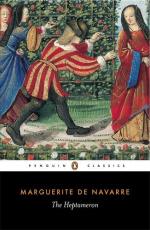2 Paulin Paris’s Manuscrits francois de la Bibliotheque du Roi, &c., Paris, 1836, vol. i. pp. 279-281. The miniature in question is contained in MS. No. 6808: Commentaire sur le Livre des Echecs amoureux et Archiloge Sophie.
Whatever time Margaret may have devoted to diversion, she was certainly a very studious child, for at fifteen years of age she already had the reputation of being highly accomplished. Shortly after her sixteenth birthday a great change took place in her life. On August 3rd, 1508, Louise of Savoy records in her journal that Francis “this day quitted Amboise to become a courtier, and left me all alone.” Margaret accompanied her brother upon his entry into the world, the young couple repairing to Blois, where Louis XII. had fixed his residence. There had previously been some unsuccessful negotiations in view of marrying Margaret to Prince Henry of England (Henry VIII.), and at this period another husband was suggested in the person of Charles of Austria, Count of Flanders, and subsequently Emperor Charles V. Louis XII., however, had other views as regards the daughter of the Count of Angouleme, for he knew that if he himself died without male issue the throne would pass to Margaret’s brother. Hence he decided to marry her to a prince of the royal house, Charles, Duke of Alencon.
This prince, born at Alencon on September 2nd, 1489, had been brought up at the Chateau of Mauves, in Le Perche, by his mother, the pious and charitable Margaret of Lorraine, who on losing her husband had resolved, like Louise of Savoy, to devote herself to the education of her children. (1)
1 Hilarion de Coste’s
Vies et Eloges des Dames illustres,
vol. ii. p. 260.
It had originally been intended that her son Charles should marry Susan, daughter of the Duke and Duchess of Bourbon—the celebrated Peter and Anne de Beaujeu—but this match fell through owing to the death of Peter and the opposition of Anne, who preferred the young Count of Montpensier (afterwards Constable de Bourbon) as a son-in-law. A yet higher alliance then presented itself for Charles: it was proposed that he should marry Anne of Brittany, the widow of King Charles VIII., but she was many years his senior, and, moreover, to prevent the separation of Brittany from France, it had been stipulated that she should marry either her first husband’s successor (Louis XII.) or the heir-presumptive to the throne. Either course seemed impracticable, as the heir, Francis of Angouleme, was but a child, while the new King was already married to Jane, a daughter of Louis XI. Brittany seemed lost to France, when Louis XII., by promising the duchy of Valentinois to Caesar Borgia, prevailed upon Pope Alexander VI. to divorce him from his wife. He then married Anne of Brittany, while Charles of Alencon proceeded to perfect his knightly education, pending other matrimonial arrangements.




